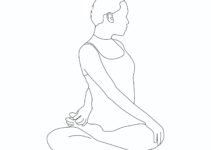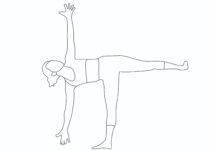What is the meaning of Plow Pose?
The plow pose in Sanskrit is known as Halasana. Halasana is so-called because, in its final pose, it resembles a plow. Halasana can be classified as ‘ hah-LAHS-anna. Hala means plough or plough. The plow pose is both a forward bending and a semi-inverted pose. Practising plough pose and Sarvangasana prepares you for the more advanced yoga poses. Here, simple and easy steps of the yoga pose have been mentioned. Halasana’s researched benefits have also been mentioned. However, specific contraindications should also be considered while performing the pose.

How to do plough pose steps of doing Halasana.
- Lie flat on the floor, facing upward.
- The legs should be straight and together.
- Slowly raise the legs to the vertical position; use the abdominal muscles as much as possible and the arms as little as possible.
- Raise the legs over the head; the buttocks and hips should be simultaneously raised.
- Slowly lower the feet toward the ground behind the head and, if possible, touch the toes to the floor behind the head.
- Those who cannot touch their feet on the ground can allow their feet to suspend above the floor.
- For the entire process, the legs should be straight.
- Do breathing slowly and deeply.
- This is the final pose, and stay here at your convenience.
- While coming to the original position, the arms should be placed behind the back.
Breathing pattern for plow pose
- Inhale while raising the legs at 90 degrees.
- Exhale while bringing your legs to the ground.
- While maintaining the pose, inhale and exhale slowly.
- Take a deep breathing and come to the original position.
Advice to beginners
- It is difficult for beginners to touch the toes to the floor behind the head.
- For beginners, it is better to suspend the feet above the floor, keeping the legs straight.
- Beginners should place their fists under the buttocks with the knuckles facing upwards.
- Practice it regularly to make the back more supple so the toes gradually move nearer to the ground.
- The primary focus should be to stretch the muscles progressively, not permanently, by force.
- The practice of yoga poses like paschimottanasana, yoga mudra, janu sirshasana and shashankasana will help the practitioners to be perfect in halasana.
Duration
- For a practitioner, it can be maintained for up to five minutes and even more at one’s convenience.
- Beginners should start with about ten to twenty seconds in the final pose and increase by a few seconds daily.
- If you don’t want to count seconds, do at least ten breathing in the final stage.
Sequence
It is better to follow the following sequence while practising halasana
- Sarvangasana
- Lower the feet into halasana
- Some or all of the variations
- Return to lying position on the floor
- Counterpose: Any backward bending yoga poses can be used as a counterpose of halasana. However, the best yoga poses, which can be done as a counterpose, are matsyasana ushtrasana. supta vajrasana and chakrasana
Time to perform
- The best time to practice plough pose is early in the morning before breakfast and late in the afternoon before dinner.
- The yoga pose should not be practised after meals or vigorous exercises.
Plough pose contraindications
There are a few limitations of plow pose. These contraindications should be kept in mind while practising halasana.
- People who suffer from hernia, slipped disc, sciatica, high blood pressure, or any severe back ailments should not do halasana.
- One shouldn’t use force or sudden jerks to touch the floor under any circumstances.
- If you are still in doubt, take the guidance of a yoga expert.
Plow pose tips for best benefits.
- For maximum benefits of the pose, use only the abdominal muscles to raise the legs without any help of the arms.
- Before returning to the starting position, the arms should be placed behind the back to minimise strain.
- While returning to the original position, the movement should be slow and controlled, using the abdominal muscles as much as possible.
- The legs should be lowered gently to the ground without any thud.
- The back of the head should remain in contact with the floor throughout.
Nine Amazing Benefits of Plow Pose
- Plow pose makes the entire spine supple.
- The practising of it helps to stretch the muscles and loosens the vertebrae.
- Halasana tones the nerves both inside and outside the spinal column. This leads to better efficiency of all the organs in the body.
- Since the practice of the plough poses exerts pressure on the neck region, it enhances the efficiency of the thyroid and parathyroid glands.
- The abdominal organs are massaged, and muscles are strengthened. Accordingly, it helps alleviate constipation, dyspepsia, diabetes, and other abdominal ailments.
- It helps to decongest and revitalise the liver, spleen, kidneys, pancreas, and adrenal glands.
- Plow pose helps to remove backache, neck ache, and headache.
- The regular practice of it induces the states of pratyahara (sense withdrawal), which is suitable for meditation.
- The practice of it is good for high blood pressure as they will not feel a rush of blood in the head region.
Joint actions
The following joints are involved while practising the plow pose. Spine cervical flexion; thoracic flexion; lumbar flexion; sacroiliac joint nutation; hip flexion, adduction, internal rotation; knee extension; ankle dorsiflexion; toe extension; scapula adduction, downward rotation, elevation; glenohumeral joint external rotation, extension, adduction; elbow extension; forearm pronation; wrist extension; finger and hand flexion to clasp hands.





